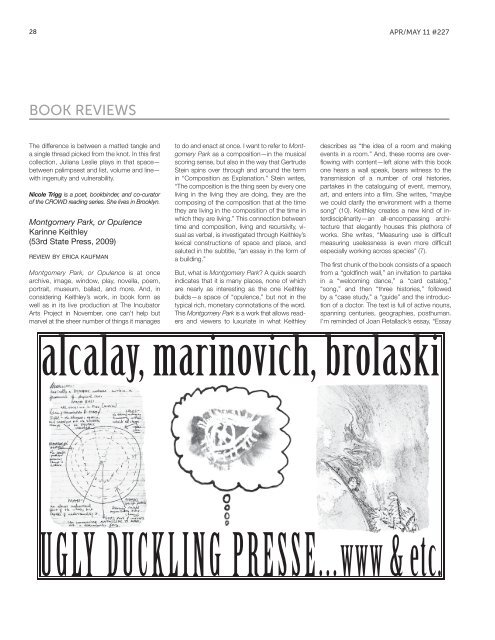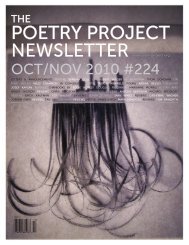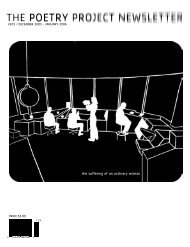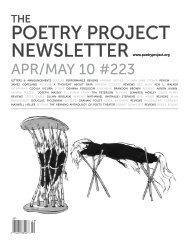28 APR/MAY 11 #227BOOK REVIEWS<strong>The</strong> difference is between a matted tangle anda single thread picked from the knot. In this firstcollection, Juliana Leslie plays in that space—between palimpsest and list, volume and line—with ingenuity and vulnerability.Nicole Trigg is a poet, bookbinder, and co-curatorof the CROWD reading series. She lives in Brooklyn.Montgomery Park, or OpulenceKarinne Keithley(53rd State Press, 2009)review by erica kaufmanMontgomery Park, or Opulence is at oncearchive, image, window, play, novella, poem,portrait, museum, ballad, and more. And, inconsidering Keithley’s work, in book form aswell as in its live production at <strong>The</strong> IncubatorArts <strong>Project</strong> in November, one can’t help butmarvel at the sheer number of things it managesto do and enact at once. I want to refer to MontgomeryPark as a composition—in the musicalscoring sense, but also in the way that GertrudeStein spins over through and around the termin “Composition as Explanation.” Stein writes,“<strong>The</strong> composition is the thing seen by every oneliving in the living they are doing, they are thecomposing of the composition that at the timethey are living in the composition of the time inwhich they are living.” This connection betweentime and composition, living and recursivity, visualas verbal, is investigated through Keithley’slexical constructions of space and place, andsaluted in the subtitle, “an essay in the form ofa building.”But, what is Montgomery Park? A quick searchindicates that it is many places, none of whichare nearly as interesting as the one Keithleybuilds—a space of “opulence,” but not in thetypical rich, monetary connotations of the word.This Montgomery Park is a work that allows readersand viewers to luxuriate in what Keithleydescribes as “the idea of a room and makingevents in a room.” And, these rooms are overflowingwith content—left alone with this bookone hears a wall speak, bears witness to thetransmission of a number of oral histories,partakes in the cataloguing of event, memory,art, and enters into a film. She writes, “maybewe could clarify the environment with a themesong” (10). Keithley creates a new kind of interdisciplinarity—anall-encompassing architecturethat elegantly houses this plethora ofworks. She writes, “Measuring use is difficultmeasuring uselessness is even more difficultespecially working across species” (7).<strong>The</strong> first chunk of the book consists of a speechfrom a “goldfinch wall,” an invitation to partakein a “welcoming dance,” a “card catalog,”“song,” and then “three histories,” followedby a “case study,” a “guide” and the introductionof a doctor. <strong>The</strong> text is full of active nouns,spanning centuries, geographies, posthuman.I’m reminded of Joan Retallack’s essay, “Essay
THE POETRY PROJECT NEWSLETTER29as Wager,” in which she writes, “the most vitalmeaning has always come out of a dicey collaborationof intellect and imagination.” I think thatpart of Keithley’s work’s great accomplishmentis the way she straddles the hypothetically fictionalwith a cloak of mastery—mastery of multiplegenres, of composition itself in all its amorphousness,and a William Jamesian attentionto the “constituents of the Self.” What does itmean to build such a prolific archive for a placethat perhaps doesn’t exist? What does it meanto be “accounted for”? And, what does this implyabout the function of the archive, the art,the body? To return to Stein, perhaps “nothingchanges from generation to generation exceptthe thing seen and that makes a composition.”In “Its Solution” (the second segment of “CaseStudy C”), Keithley writes, “one day I foundwords so accurate it seemed to energize theemptiness against me…I ran to the walls ofthe room to prove to myself that at least thisoutward container was still there” (39). <strong>The</strong>sentiment here is that of a body enveloped byair, by space, by negative capability. Yet, it isthe “accuracy” that is striking—the accuracyof Keithley’s diction, her attention to words asunits, sentences as Steinian syntactical units atplay. <strong>The</strong>re is always an “outward container,”but this narrator makes the “poethical” connectionto the strange “intermediate zone between selfand world, in the distancing act of play” (Retallack).In “Guide,” we are “invited to take a look around,and if you have any questions about the wallsplease feel free to ask” (42). Particularly resonantin live performance/installation, this is themoment when audience/reader walks throughthe text alone, at his/her own pace, engagingwith these articulate walls. Retallack unpacksher notion of “poethics” as “what we make ofevents as we use language in the present, howwe continuously create an ethos of the way inwhich events are understood.” An invitation tospeak to a wall, to inquire about a room’s contents,brings the reader/viewer into a kind ofcontinuous present/presence. Keithley achieves(consistently) this kind of “poethical” momentwhere constructions of memory, the politics ofnostalgia, and a place we might not know allcome into dialogue, speak and swerve in themost productive ways, like Epicurus’ clinamen.<strong>The</strong> text then moves into a “fire story,” a “film,”“Spinozan calisthenics,” “post script,” and “appendix.”We meet Adam Gordon Griswold, andlearn the story of this Montgomery Park’s fire.We see an acknowledgement of progress, ofthe details that populate this space, and thevoices that surface in letter and diary. Keithleywrites, “she had been put away in one of thoseregions we send for in our imagined rehabilitation”(51) and later, “the rush of all pronounsaway from anything corporeal” (53). <strong>The</strong>se arepeople speaking, walls speaking singed, bodiesde-gendered, “the building, to which shehad lost her own identity” (53). We hear DoctorMontgomery interrogated, remarking, “you area photograph!” (75). Gregory Pardlo commentsthat Keithley’s writing is “a lesson in the varietiesof awareness the human animal can achieve,”and this awareness enables one to navigatethrough a burning building rebuilt, a photographnever taken, and finally, “hand drawn messageessay to who and on what?” (90)<strong>The</strong> term “essay” comes from the French word,“essayer,” which means “to try.” And, whatKeithley valiantly and dynamically achieves isa foray into architecture—one that is inscribedwith memory, mind body. <strong>The</strong> text concludes,“I put my arm out into white space inhabit myarchive in waiting” (90).Erica Kaufman is the author of Censory Impulse(Factory School, 2010).
















